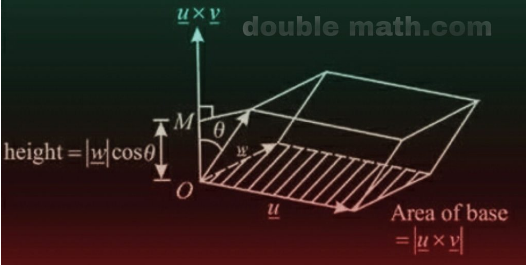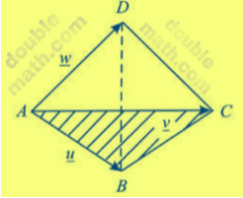There are two types of triple product of vectors
(a) Scalar Triple Product : ![]() or
or ![]()
(b) Vector Triple Product : ![]()
In this section, we shall study the scalar triple product only
Definition : let ![]() =
= ![]() +
+ ![]() +
+ ![]() ,
, ![]() =
= ![]() +
+ ![]() +
+ ![]() ,
, ![]() =
= ![]() +
+ ![]() +
+ ![]() The scalar triple product of vector
The scalar triple product of vector ![]() ,
, ![]() and
and ![]() is defined by
is defined by ![]() . (
. ( ![]() ×
× ![]() ) or
) or ![]() .(
.( ![]() ×
×![]() ) or
) or ![]() .(
.( ![]() ×
× ![]() ) The scalar triple product
) The scalar triple product ![]() . (
. ( ![]() ×
× ![]()
![]() ) is written as
) is written as ![]() . (
. ( ![]() ×
× ![]() ) =[
) =[ ![]() ]
]
Analytical Expression Of  . (
. ( 
 )
)
Let ![]() =
= ![]() +
+ ![]() +
+ ![]() ,
, ![]() =
= ![]() +
+ ![]() +
+ ![]() ,
, ![]() =
= ![]() +
+ ![]() +
+ ![]()

Important Note : (1) The value of the triple scalar product depends upon the cycle order of the vectors , but is independent of the dot and cross. So the dot and cross , may be interchanged without alternating the value i.e; (2) (![]() ×
× ![]() )
) ![]() =
= ![]() (
(![]() ×
× ![]() ) = [
) = [ ![]() ]
]
(![]() ×
× ![]() )
) ![]() =
= ![]() (
(![]() ×
× ![]() ) = [
) = [ ![]() ]
]
(![]() ×
× ![]() )
) ![]() =
= ![]() (
(![]() ×
× ![]() ) = [
) = [ ![]() ]
]
(3) The value of the product changes if the order is non cyclic .
(4) (![]() .
. ![]() .
. ![]() and
and ![]() × (
× (![]() .
. ![]() )
)
Applications Of Scalar Triple Product :
- The Volume Of The Parallelepiped
- The Volume Of The Tetrahedron
(1) The Volume Of The Parallelepiped :
The triple scalar product (![]() ×
× ![]() )
) ![]() represents the volume of the parallelepiped having
represents the volume of the parallelepiped having ![]() ,
, ![]() and
and ![]() as its conterminous edges. As it is seen from the formula that:
as its conterminous edges. As it is seen from the formula that:

(![]() ×
× ![]() )
) ![]() =
= ![]()
![]() Hence
Hence
(i) ![]() = area of the parallelogram with two adjacent sides,
= area of the parallelogram with two adjacent sides, ![]() and
and ![]()
(ii) ![]() = height of the parallelepiped
= height of the parallelepiped
(![]() ×
× ![]() )
) ![]() =
= ![]()
![]() =(Area of parallelogram)(height)
=(Area of parallelogram)(height)
= Volume of the parallelepiped Similarly, by taking the base plane formed by ![]() and
and ![]() , we have
, we have
The volume of the parallelepiped = (![]() ×
× ![]() )
) ![]()
And by taking the base plane formed by ![]() and
and ![]() , we have
, we have
The volume of the parallelepiped = (![]() ×
× ![]() )
) ![]()
So, we have: (![]() ×
× ![]() )
) ![]() = (
= (![]() ×
× ![]() )
) ![]() = (
= (![]() ×
× ![]() )
) ![]()
(2) The Volume Of The Tetrahedron :

Volume of the tetrahedron ABCD
=![]() (
( ![]() ABC)(height of D above the place ABCD)
ABC)(height of D above the place ABCD)
= ![]()
= ![]() (Area of parallelogram with AB and AC as adjacent\)
(Area of parallelogram with AB and AC as adjacent\)
= ![]() (volume of the parallelogram with
(volume of the parallelogram with ![]() ,
, ![]() ,
, ![]() as edges)
as edges)
Thus volume = ![]() ×
× ![]() )
) ![]() =[ [
=[ [ ![]() ]
]
Properties of Triple scalar Product :
(1) If ![]() ,
, ![]() and
and ![]() are coplanar , then the volume of the parallelepiped so formed is zero i.e; the vectors
are coplanar , then the volume of the parallelepiped so formed is zero i.e; the vectors ![]() ,
, ![]() ,
, ![]() are coplanar
are coplanar ![]() (
(![]() ×
× ![]() )
) ![]() =0
=0
(2) If any two vectors of triple product are equal , then its value is zero i.e;
[ ![]() ] = [ [
] = [ [ ![]() ]
]
